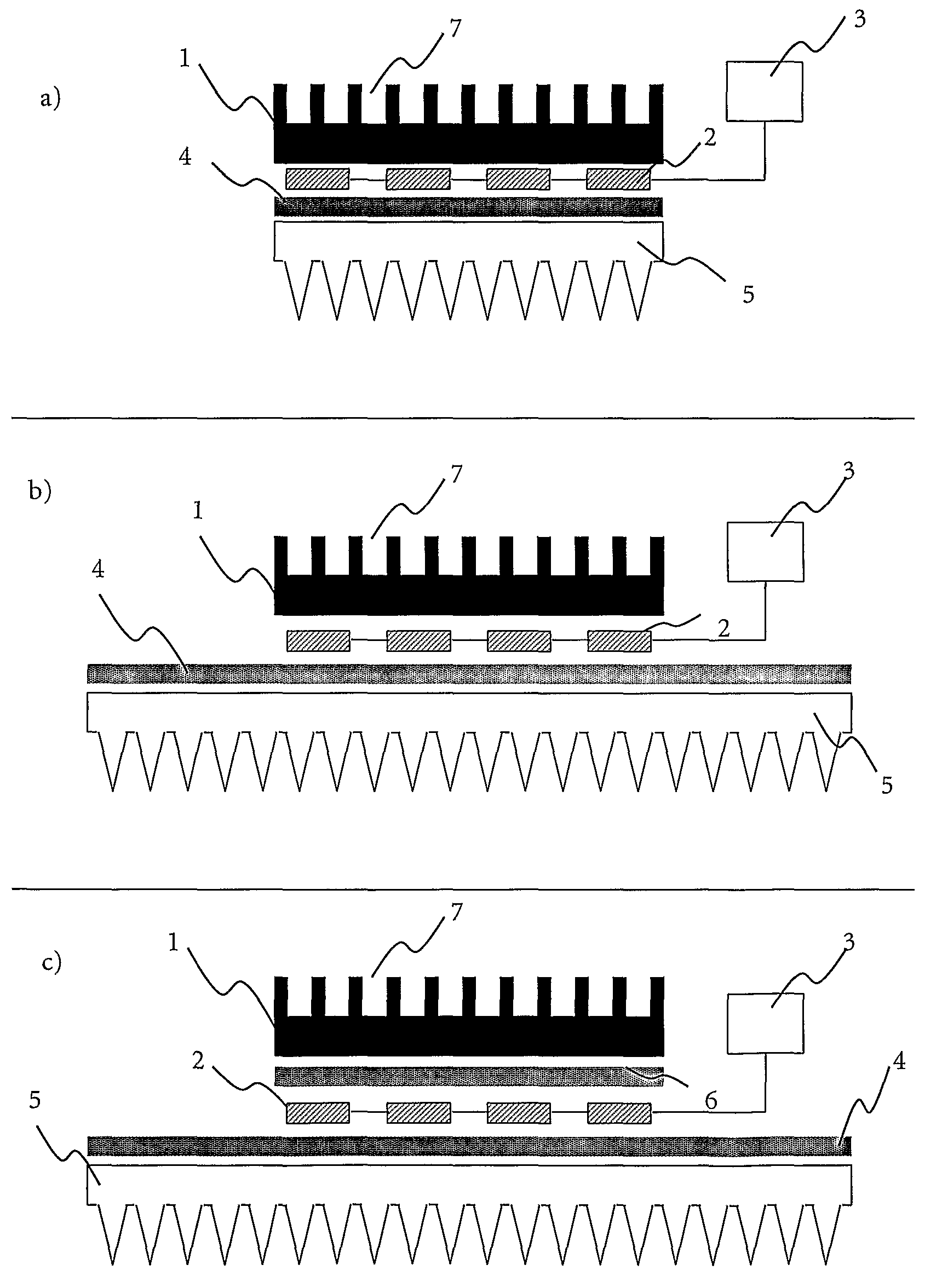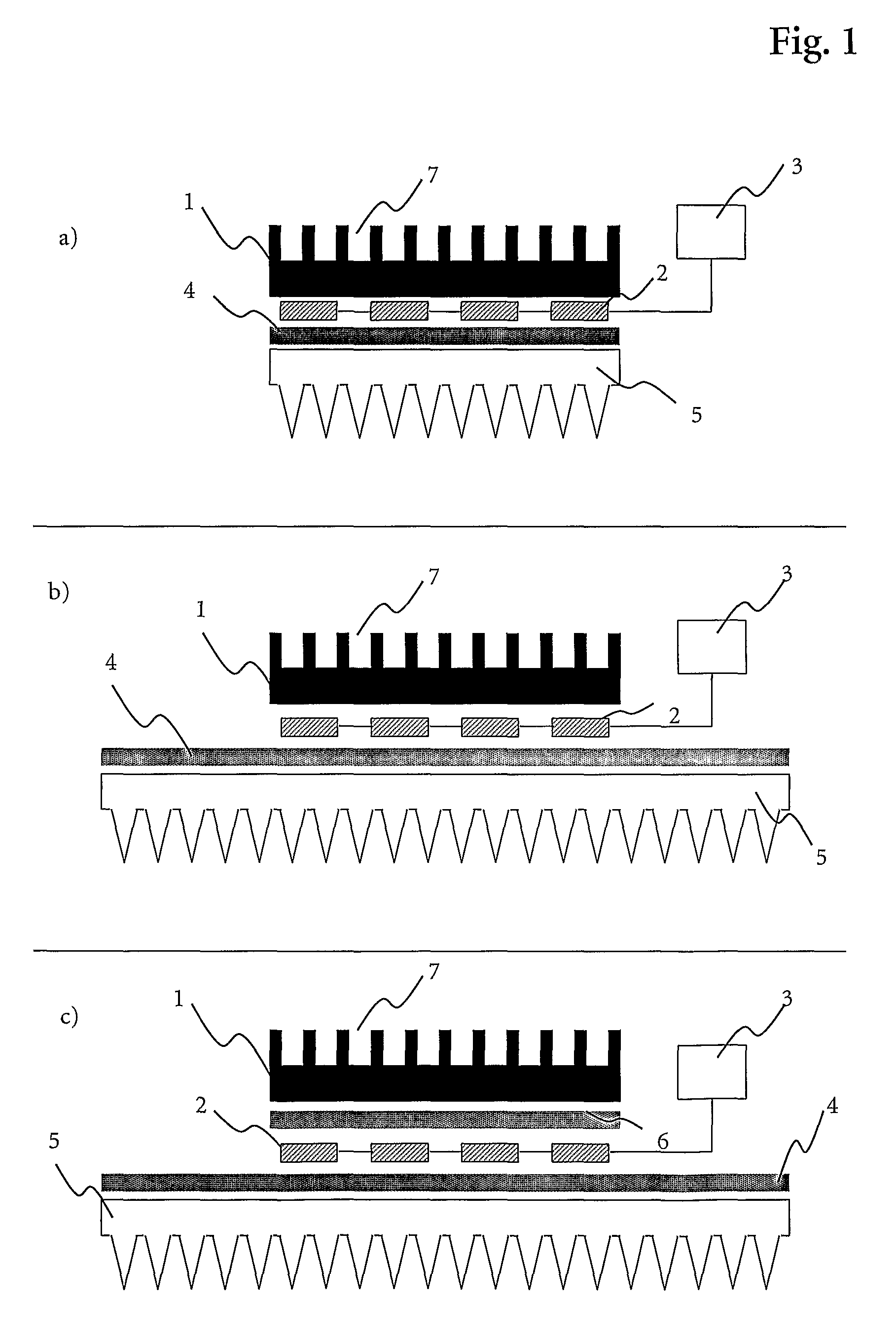Thermocycling of a Block Comprising Multiple Sample
a technology of thermal cycle and multiple samples, applied in specific use of bioreactors/fermenters, biomass after-treatment, biochemical apparatus and processes, etc., can solve the problems of not allowing temperature control of heat sinks, not able to cool components at or below ambient temperature, and unable to cool objects below ambient temperature, etc., to achieve high thermal conductivity, maximize surface area, and low cost
- Summary
- Abstract
- Description
- Claims
- Application Information
AI Technical Summary
Benefits of technology
Problems solved by technology
Method used
Image
Examples
example 1
[0179]A device according to the present invention for the thermocycling of a 384 multiwell plate comprises a homemade thermal block out of the aluminum alloy AlMgSi 0.5. An aluminum block with the dimension 109×73×9.1 mm was used to form 384 recesses by drilling, each conic recess has a top diameter of 3.44 mm (angle 17°) and a depth of 6.8 mm.
[0180]Below said thermal block 6 Peltier elements are arranged, whereas the thermal contact is enhanced via a thermal conductive graphite foil. The used Peltier elements are suitable for multiple thermocycling procedures and can heat up to 130° C. Additionally, each of them has a cooling capacity of 75 W.
[0181]Via a second thermal conductive graphite foil, the 6 Peltier elements are arranged on a thermal base. The used thermal base is customized production of Thermacore™ and has the dimension of 248×198×5 mm. The vessel wall is made out of copper and the working fluid is water.
[0182]The used heat sink is commercially available from Webra (prod...
example 2
[0184]Heat pictures of the thermal block of a device as described in Example 1 were recorded with an IR-camera (commercially available at the company FLIR) during a heating procedure (FIG. 2) and a cooling procedure (FIG. 3).
[0185]The heating procedure (FIG. 2) started at a temperature of 55° C. with a heating rate of 4° C. / s until 95° C. were reached, whereas the cooling procedure (FIG. 3) started at a temperature of 95° C. with a cooling rate of 2° C. / s until 55° C. were reached. The pictures were taking at different times during the heating procedure and cooling procedure, respectively.
example 3
[0186]In FIG. 4 different characteristic temperatures of 6 successive temperature cycles of the following thermocycling protocol are plotted as a function of time:
steptempramphold timenumberPreCycle40° C.2.0° C. / s120 sec 1MainCycle95° C.4.4° C. / s10 sec655° C.2.0° C. / s10 sec72° C.4.4° C. / s10 sec
[0187]7 different temperature profiles are included in the figure, the temperature profile of the thermocycling protocol (‘Soll Temp’), the theoretical temperature of the thermal block (‘Soll Ist’), the measured temperature of the thermal block (‘Ist Temp’), the mean temperature measured within 9 recesses of the thermal block (‘Mean’), the minimal measured temperature of said 9 recesses of the thermal block (‘Min’), the maximal measured temperature of said 9 recesses of the thermal block (‘Max’) and the homogeneity of the 9 recess measurements (‘Hom’; homogeneity=maximal recess temperature—minimal recess temperature).
[0188]A standard multiwell plate was arranged in the recesses of the thermal ...
PUM
 Login to View More
Login to View More Abstract
Description
Claims
Application Information
 Login to View More
Login to View More - R&D
- Intellectual Property
- Life Sciences
- Materials
- Tech Scout
- Unparalleled Data Quality
- Higher Quality Content
- 60% Fewer Hallucinations
Browse by: Latest US Patents, China's latest patents, Technical Efficacy Thesaurus, Application Domain, Technology Topic, Popular Technical Reports.
© 2025 PatSnap. All rights reserved.Legal|Privacy policy|Modern Slavery Act Transparency Statement|Sitemap|About US| Contact US: help@patsnap.com



